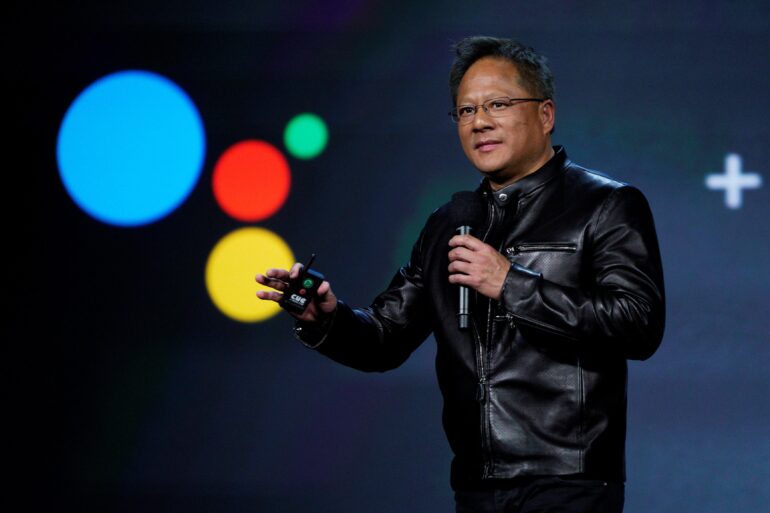TL;DR:
- Nvidia’s CEO, Jensen Huang, predicts a “new computing era” driven by generative artificial intelligence (AI).
- The DGX GH200 AI supercomputer platform is introduced, enabling the construction of powerful generative AI models.
- Generative AI can produce various types of content, such as text, imagery, audio, and synthetic data.
- It eliminates the need for traditional coding, allowing users to communicate their intentions to the computer.
- Nvidia believes generative AI is the most significant computing platform of our time, impacting industries and fostering innovation.
- Professionals can easily create visuals, accelerate application development, and even generate 3D models with simple prompts.
- Generative AI comprehends information beyond text and numbers, making it versatile and transformative.
- It enhances existing applications and creates new ones, driving progress at an unprecedented rate.
Main AI News:
In the wake of Nvidia’s impressive financial performance and the subsequent surge in its stock value, CEO Jensen Huang is boldly proclaiming the dawn of a “new computing era.” According to Huang, anyone can now assume the role of a programmer simply by engaging in a conversation with the computer, allowing desired functions to materialize effortlessly. Gone are the days when programmers would laboriously write lines of code only to encounter the dreaded “fail to compile” error due to a mere missing semicolon.
How is this groundbreaking feat to be achieved? Huang revealed that the key lies in generative artificial intelligence (AI) as he delivered his keynote address at the prestigious Computex forum in Taiwan. During the event, Huang introduced DGX GH200, a cutting-edge AI supercomputer platform designed specifically for constructing generative AI models.
Generative AI represents an advanced breed of artificial intelligence technology, capable of producing diverse forms of content encompassing text, imagery, audio, and synthetic data. “This computer,” Huang emphasized, “is indifferent to your programming approach; it endeavors to comprehend your intentions, thanks to its exceptional prowess in language modeling. Consequently, the programming hurdle has been significantly lowered. We have effectively bridged the digital divide, empowering everyone to become a programmer by simply communicating with the computer.”
Nvidia proclaims generative AI to be the “most pivotal computing platform of our time,” as individuals and enterprises embrace its potential for creating novel applications and harnessing its power. With a mere textual prompt, creative professionals can now conjure captivating visuals, while programmers can expedite application development and debugging processes. Even architects can effortlessly generate 3D models from 2D floor plans, courtesy of this groundbreaking technology.
Huang accentuated, “Throughout every epoch of computing, new possibilities emerge, previously inconceivable. Undoubtedly, artificial intelligence epitomizes this revolutionary force.” He further expounded on the distinctiveness of the present computing era, underscoring generative AI’s ability to comprehend various forms of information beyond mere text and numbers. This facet, he emphasized, is the reason behind the technology’s potential to revolutionize every industry it touches.
Diverging from the conventional models of computer application development, which necessitate the creation of new applications and hardware to accommodate advancements such as AI, Huang asserted that generative AI possesses the unprecedented capability not only to influence new applications but also to enhance existing ones. “AI,” he confidently stated, “will optimize every single existing application, rendering them superior. Moreover, it will engender entirely novel applications. The rapid pace of progress, facilitated by its user-friendly nature, is the driving force behind its exponential growth.”
As Nvidia’s visionary leader concluded his address, the magnitude of the forthcoming computing era became increasingly apparent. The transformative potential of generative AI, with its ability to comprehend and create across diverse modalities, promises to redefine the technological landscape, unlocking unprecedented possibilities for innovation and progress. With this paradigm shift, the barrier to entry for programming has been shattered, and a bold new era beckons—an era where the fusion of human ingenuity and the limitless power of AI fuels groundbreaking advancements in every sphere of human endeavor.
Conclusion:
The emergence of generative AI and its potential to revolutionize the computing landscape is poised to have a profound impact on the market. The democratization of programming through simplified communication with computers opens up opportunities for individuals and businesses to leverage generative AI across various industries. As applications become more efficient and novel ones emerge, the market will experience a surge of innovation and accelerated development. The accessibility and versatility of generative AI position it as a transformative force, driving the demand for advanced computing solutions and fueling growth in the industry.

